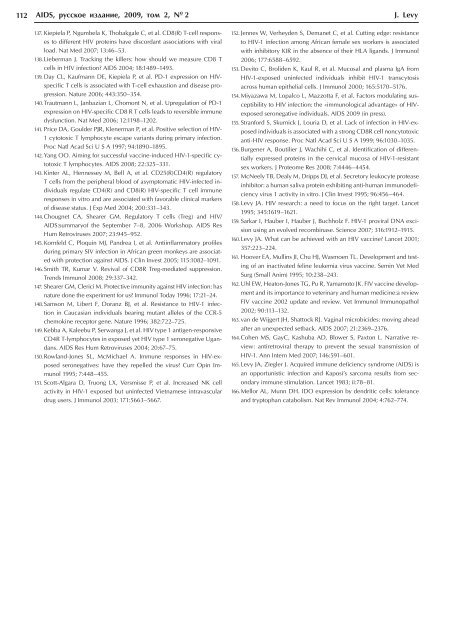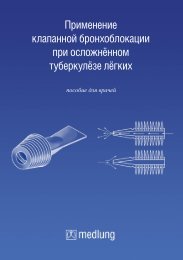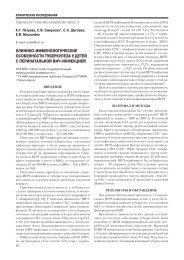Ïàòîãåíåç ÂÈ×-èíôåêöèè: <strong>25</strong> ëåò îòêðûòèé è çàãàäîê11194. Chiu YL, Soros VB, Kreisberg JF, et al. Cellular APOBEC3G restrictsHIV-1 infection in resting CD4R T cells. Nature 2005; 435:108–114.95. Stremlau M, Owens CM, Perron MJ, et al. The cytoplasmic bodycomponent TRIM5 restricts HIV-1 infection in old world monkeys.Nature 2004; 427:848–853.96. Neil SJ, Zang T, Bieniasz PD. Tetherin inhibits retrovi<strong>ru</strong>s release andis antagonized by HIV-1 Vpu. Nature 2008; 451:4<strong>25</strong>–430.97. Varthakavi V, Heimann-Nichols E, Smith RM, et al. Identification ofcalcium-modulating cyclophilin ligand as a human host restriction toHIV-1 release overcome by Vpu. Nat Med 2008; 14:641–647.98. Fellay J, Shianna KV, Ge D, et al. A whole-genome associationstudy of major determinants for host control of HIV-1. Science 2007;317:944–947.99. Konig R, Zhou Y, Elleder C, et al. Global analysis of host-pathogeninteractions that regulate early-stage HIV-1 replication. Cell 2008;135:49–60.100. Brass AL, Dykxhoorn DM, Benita Y, et al. Identification of hostproteins required for HIV infection through a functional genomicscreen. Science 2008; 319:921–926.101. Akira S, Uematsu S, Takeuchi O. Pathogen recognition and innateimmunity. Cell 2006; 124:783–801.102. Fust G, Ujhelyi E, Hidvegi T, et al. The complement system in HIVdisease. Immunol Invest 1991; 20:231–241.103. Hart ML, Saifuddin M, Uemura K, et al. High mannose glycans andsiliac acid on gp120 regulate binding of mannose-binding lectin(MBL) to HIV type 1. AIDS Res Hum Retrovi<strong>ru</strong>ses 2002; 18:1311–1317.104. Wada M, Wada NA, Shirono H, et al. Amino-terminal fragment ofurokinase-type plasminogen activator inhibits HIV-1 replication.Biochem Biophys Res Commun 2001; 284:346–351.105. Munch J, Standker L, Adermann K, et al. Discovery and optimizationof a natural HIV-1 entry inhibitor targeting the gp41 fusion peptide.Cell 2007; 129:263–275.106. Rodman TC, Lutton JD, Jiang S, Al-Kouatly HB, Winston R. Circulatingnatural IgM antibodies and their corresponding human cordblood cell-derived Mabs specifically combat the Tat protein of HIV.Exp Hematol 2001; 29:1004–1009.107. Lobo PI, Schlegel KH, Yuan W, Townsend GC, White JA. Inhibitionof HIV-1 infectivity through an innate mechanism involving naturallyoccurring IgM antileukocyte autoantibodies. J Immunol 2008;180:1769–1779.108. Gomez MB, Hildreth JEK. Antibody to adhesion molecule LFA-1enhances plasma neutralization of human immunodeficiency vi<strong>ru</strong>stype 1. J Virol 1995; 69:4628–4632.109. Rizzuto CD, Sodroski JG. Contribution of virion ICAM-1 to humanimmunodeficiency vi<strong>ru</strong>s infectivity and sensitivity to neutralization.J Virol 1997; 71:4847–4851.110. Wang SK, Liang PH, Astronomo RD, et al. Targeting the carbohydrateson HIV-1: Interaction of oligomannose dendrons with humanmonoclonal antibody 2G12 and DC-SIGN. Proc Natl Acad Sci U S A2008; 105:3690–3695.111. Burton DR, Stanfield RL, Wilson IA. Antibody vs. HIV in a clashof evolutionary titans. Proc Natl Acad Sci U S A 2005; 102:14943–14948.112. Salzwedel K, Smith ED, Dey B, Berger EA. Sequential CD4-coreceptorinteractions in human immunodeficiency vi<strong>ru</strong>s type 1 Env function:soluble CD4 activates Env for coreceptor-dependent fusion andreveals blocking activities of antibodies against cryptic conservedepitopes on gp120. J Virol 2000; 74:326–333.113. Decker JM, Bibollet-Ruche F, Wei X, et al. Antigenic conservationand immunogenicity of the HIV coreceptor binding site. J Exp Med2005; 201:1407–1419.114. Ahmad R, Sindhu ST, Toma E, et al. Evidence for a correlation betweenantibody-dependent cellular cytotoxicity-mediating anti-HIV-1 antibodies and prognostic predictors of HIV infection. J ClinImmunol 2001; 21:227–233.115. Homsy J, Meyer M, Levy JA. Se<strong>ru</strong>m enhancement of human immunodeficiencyvi<strong>ru</strong>s (HIV) correlates with disease in HIV infected individuals.J Virol 1990; 64:1437–1440.116. Morrow WJW, Isenberg DA, Sobol RE, Stricker RB, Kieber-EmmonsT. AIDS vi<strong>ru</strong>s infection and autoimmunity: A perspective of the clinical,immunological, and molecular origins of the autoallergic pathologiesassociated with HIV disease. Clin Immunol Immunopathol1991; 58:163–180.117. Banchereau J, Steinman RM. Dendritic cells and the control of immunity.Nature 1998; 392:245–<strong>25</strong>2.118. Donaghy H, Stebbing J, Petterson S. Antigen presentation and therole of dendritic cells in HIV. Curr Opin Infect Dis 2004; 17:1–6.119. Liu YJ. IPC: professional type 1 interferon-producing cells andplasmacytoid dendritic cell precursors. Annu Rev Immunol 2005;23:275–306.120. Siegal FP, Kadowaki N, Shodell M, et al. The nature of the principaltype 1 interferon-producing cells in human blood. Science 1999;284:1835–1837.121. Schmidt B, Scott I, Whitmore RG, et al. Low-level HIV infection ofplasmacytoid dendritic cells: onset of cytopathic effects and celldeath after PDC maturation. Virology 2004; 329:280–288.122. Soumelis V, Scott I, Gheyas F, et al. Depletion of circulating naturaltype 1 interferon-producing cells in HIV-infected AIDS patients.Blood 2001; 98:906–912.123. Killian MS, Fujimura S, Hecht FM, Levy JA. Similar changes in plasmacytoiddendritic cell and CD4R T cell counts during primary HIV-1 infection and treatment. AIDS 2006; 20:1247–1<strong>25</strong>2.124. Malleret B, Maneglier B, Karlsson I, et al. Primary infection with simianimmunodeficiency vi<strong>ru</strong>s: plasmacytoid dendritic cell homingto lymph nodes, type I IFN and immune suppression. Blood 2008.[Epub ahead of print].1<strong>25</strong>. Kottilil S, Shin K, Planta M, et al. Expression of chemokine and inhibitoryreceptors on natural killer cells: effect of immune activationand HIV viremia. J Infect Dis 2004; 189:1193–1198.126. Martin MP, Qi Y, Gao X, et al. Innate partnership of HLA-B andKIR3DL1 subtypes against HIV-1. Nat Genet 2007; 39:733–740.127. Godfrey DI, Kronenberg M. Going both ways: immune regulationvia CD1d-dependent NKT cells. J Clin Invest 2004; 114:1379–1388.128. Moser B, Brandes M. Gammadelta T cells: an alternative type of professionalAPC. Trends Immunol 2006; 27:112–118.129. Norris PJ, Moffett HF, Yang OO, et al. Beyond help: direct effectorfunctions of human immunodeficiency vi<strong>ru</strong>s type 1-specific CD4R Tcells. J Virol 2004; 78:8844–8851.130. Betts MR, Nason MC, West SM, et al. HIV nonprogressors preferentiallymaintain highly functional HIV-specific CD8R T-cells. Blood2006; 107:4781–4789.131. Rosenberg ES, Billingsley JM, Caliendo AM, et al. Vigorous HIV-1-specific CD4R T cell responses associated with control of viremia.Science 1997; 278:1447–1450.132. Kalams SA, Buchbinder SP, Rosenberg ES, et al. Association betweenvi<strong>ru</strong>s-specific cytotoxic T-lymphocyte and helper responsesin human immunodeficiency vi<strong>ru</strong>s type 1 infection. J Virol 1999;73:6715–6720.133. Guidotti LG, Ando K, Hobbs MV, et al. Cytotoxic T lymphocytes inhibithepatitis B vi<strong>ru</strong>s gene expression by a noncytolytic mechanismin transgenic mice. Proc Natl Acad Sci U S A 1994; 91:3764–3768.134. Khana KM, Lepisto AJ, Hendricks RL. Immunity to latent viral infection:many skirmishes but few fatalities. Trends Immunol 2004;<strong>25</strong>:230–234.135. Iversen AC, Norris PS, Ware CF, Benedict CA. Human NK cells inhibitcytomegalovi<strong>ru</strong>s replication through a noncytolytic mechanisminvolving lymphotoxin-dependent induction of IFN-beta. J Immunol2005; 175:7568–7574.136. Ogg GS, Jin X, Bonhoeffer S, et al. Quantitation of HIV-1-specific cytotoxicT lymphocytes and plasma load of viral RNA. Science 1998;279:2103–2106.
112 AIDS, ðóññêîå èçäàíèå, 2009, òîì 2, N¹ 2 J. Levy137. Kiepiela P, Ngumbela K, Thobakgale C, et al. CD8(R) T-cell responsesto different HIV proteins have discordant associations with viralload. Nat Med 2007; 13:46–53.138. Lieberman J. Tracking the killers: how should we measure CD8 Tcells in HIV infection? AIDS 2004; 18:1489–1493.139. Day CL, Kaufmann DE, Kiepiela P, et al. PD-1 expression on HIVspecificT cells is associated with T-cell exhaustion and disease progression.Nature 2006; 443:350–354.140. Trautmann L, Janbazian L, Chomont N, et al. Upregulation of PD-1expression on HIV-specific CD8 R T cells leads to reversible immunedysfunction. Nat Med 2006; 12:1198–1202.141. Price DA, Goulder PJR, Klenerman P, et al. Positive selection of HIV-1 cytotoxic T lymphocyte escape variants during primary infection.Proc Natl Acad Sci U S A 1997; 94:1890–1895.142. Yang OO. Aiming for successful vaccine-induced HIV-1-specific cytotoxicT lymphocytes. AIDS 2008; 22:3<strong>25</strong>–331.143. Kinter AL, Hennessey M, Bell A, et al. CD<strong>25</strong>(R)CD4(R) regulatoryT cells from the peripheral blood of asymptomatic HIV-infected individualsregulate CD4(R) and CD8(R) HIV-specific T cell immuneresponses in vitro and are associated with favorable clinical markersof disease status. J Exp Med 2004; 200:331–343.144. Chougnet CA, Shearer GM. Regulatory T cells (Treg) and HIV/AIDS:summaryof the September 7–8, 2006 Workshop. AIDS ResHum Retrovi<strong>ru</strong>ses 2007; 23:945–952.145. Kornfeld C, Ploquin MJ, Pandrea I, et al. Antiinflammatory profilesduring primary SIV infection in African green monkeys are associatedwith protection against AIDS. J Clin Invest 2005; 115:1082–1091.146. Smith TR, Kumar V. Revival of CD8R Treg-mediated suppression.Trends Immunol 2008; 29:337–342.147. Shearer GM, Clerici M. Protective immunity against HIV infection: hasnature done the experiment for us? Immunol Today 1996; 17:21–24.148. Samson M, Libert F, Doranz BJ, et al. Resistance to HIV-1 infectionin Caucasian individuals bearing mutant alleles of the CCR-5chemokine receptor gene. Nature 1996; 382:722–7<strong>25</strong>.149. Kebba A, Kaleebu P, Serwanga J, et al. HIV type 1 antigen-responsiveCD4R T-lymphocytes in exposed yet HIV type 1 seronegative Ugandans.AIDS Res Hum Retrovi<strong>ru</strong>ses 2004; 20:67–75.150. Rowland-Jones SL, McMichael A. Immune responses in HIV-exposedseronegatives: have they repelled the vi<strong>ru</strong>s? Curr Opin Immunol1995; 7:448–455.151. Scott-Algara D, T<strong>ru</strong>ong LX, Versmisse P, et al. Increased NK cellactivity in HIV-1 exposed but uninfected Vietnamese intravasculard<strong>ru</strong>g users. J Immunol 2003; 171:5663–5667.152. Jennes W, Verheyden S, Demanet C, et al. Cutting edge: resistanceto HIV-1 infection among African female sex workers is associatedwith inhibitory KIR in the absence of their HLA ligands. J Immunol2006; 177:6588–6592.153. Devito C, Broliden K, Kaul R, et al. Mucosal and plasma IgA fromHIV-1-exposed uninfected individuals inhibit HIV-1 transcytosisacross human epithelial cells. J Immunol 2000; 165:5170–5176.154. Miyazawa M, Lopalco L, Mazzotta F, et al. Factors modulating susceptibilityto HIV infection: the «immunological advantage» of HIVexposedseronegative individuals. AIDS 2009 (in press).155. Stranford S, Skurnick J, Louria D, et al. Lack of infection in HIV-exposedindividuals is associated with a strong CD8R cell noncytotoxicanti-HIV response. Proc Natl Acad Sci U S A 1999; 96:1030–1035.156. Burgener A, Boutilier J, Wachihi C, et al. Identification of differentiallyexpressed proteins in the cervical mucosa of HIV-1-resistantsex workers. J Proteome Res 2008; 7:4446–4454.157. McNeely TB, Dealy M, Dripps DJ, et al. Secretory leukocyte proteaseinhibitor: a human saliva protein exhibiting anti-human immunodeficiencyvi<strong>ru</strong>s 1 activity in vitro. J Clin Invest 1995; 96:456–464.158. Levy JA. HIV research: a need to focus on the right target. Lancet1995; 345:1619–1621.159. Sarkar I, Hauber I, Hauber J, Buchholz F. HIV-1 proviral DNA excisionusing an evolved recombinase. Science 2007; 316:1912–1915.160. Levy JA. What can be achieved with an HIV vaccine? Lancet 2001;357:223–224.161. Hoover EA, Mullins JI, Chu HJ, Wasmoen TL. Development and testingof an inactivated feline leukemia vi<strong>ru</strong>s vaccine. Semin Vet MedSurg (Small Anim) 1995; 10:238–243.162. Uhl EW, Heaton-Jones TG, Pu R, Yamamoto JK. FIV vaccine developmentand its importance to veterinary and human medicine:a reviewFIV vaccine 2002 update and review. Vet Immunol Immunopathol2002; 90:113–132.163. van de Wijgert JH, Shattock RJ. Vaginal microbicides: moving aheadafter an unexpected setback. AIDS 2007; 21:2369–2376.164. Cohen MS, GayC, Kashuba AD, Blower S, Paxton L. Narrative review:antiretroviral therapy to prevent the sexual transmission ofHIV-1. Ann Intern Med 2007; 146:591–601.165. Levy JA, Ziegler J. Acquired immune deficiency syndrome (AIDS) isan opportunistic infection and Kaposi’s sarcoma results from secondaryimmune stimulation. Lancet 1983; ii:78–81.166. Mellor AL, Munn DH. IDO expression by dendritic cells: toleranceand tryptophan catabolism. Nat Rev Immunol 2004; 4:762–774.
- Page 3 and 4: РУССКОЕ ИЗДАНИЕПре
- Page 7 and 8: Òîì 2 N¹ 2 Àïðåëü - È
- Page 9 and 10: 100 AIDS, ðóññêîå èçäàí
- Page 11 and 12: 102 AIDS, ðóññêîå èçäàí
- Page 13 and 14: 104 AIDS, ðóññêîå èçäàí
- Page 15 and 16: 106 AIDS, ðóññêîå èçäàí
- Page 17 and 18: 108 AIDS, ðóññêîå èçäàí
- Page 19: 110 AIDS, ðóññêîå èçäàí
- Page 23 and 24: 114 AIDS, ðóññêîå èçäàí
- Page 26 and 27: Ôàðìàêîëîãèÿ ïðîòè
- Page 28 and 29: Ôàðìàêîëîãèÿ ïðîòè
- Page 30 and 31: Ôàðìàêîëîãèÿ ïðîòè
- Page 32 and 33: ÎÁÇÎÐÛ ÐÅÄÀÊÖÈÈÇîë
- Page 34 and 35: Çîëåäðîíîâàÿ êèñëî
- Page 36 and 37: Çîëåäðîíîâàÿ êèñëî
- Page 38 and 39: Çîëåäðîíîâàÿ êèñëî
- Page 40 and 41: Çîëåäðîíîâàÿ êèñëî
- Page 42 and 43: Òîì 2 N¹ 2 Àïðåëü - È
- Page 44 and 45: 136 AIDS, ðóññêîå èçäàí
- Page 46 and 47: 138 AIDS, ðóññêîå èçäàí
- Page 48 and 49: 140 AIDS, ðóññêîå èçäàí
- Page 50 and 51: ÊËÈÍÈ×ÅÑÊÈÅ ÈÑÑËÅÄ
- Page 52 and 53: 144 AIDS, ðóññêîå èçäàí
- Page 54 and 55: 146 AIDS, ðóññêîå èçäàí
- Page 56 and 57: 148 AIDS, ðóññêîå èçäàí
- Page 58 and 59: 150 AIDS, ðóññêîå èçäàí
- Page 60 and 61: 152 AIDS, ðóññêîå èçäàí
- Page 62 and 63: 154 AIDS, ðóññêîå èçäàí
- Page 64 and 65: ÊËÈÍÈ×ÅÑÊÈÅ ÈÑÑËÅÄ
- Page 66 and 67: ÝÏÈÄÅÌÈÎËÎÃÈß È ÑÎ
- Page 68 and 69: Ñâÿçü ìåæäó Mycoplasma ge
- Page 70 and 71:
Ñâÿçü ìåæäó Mycoplasma ge
- Page 72 and 73:
Ñâÿçü ìåæäó Mycoplasma ge
- Page 74 and 75:
Ñâÿçü ìåæäó Mycoplasma ge
- Page 76 and 77:
Ñâÿçü ìåæäó Mycoplasma ge
- Page 78 and 79:
Òîì 2 N¹ 2 Àïðåëü - È
- Page 80 and 81:
174 AIDS, ðóññêîå èçäàí
- Page 82 and 83:
176 AIDS, ðóññêîå èçäàí
- Page 84 and 85:
ÑÎÎÁÙÅÍÈß ÈÑÑËÅÄÎÂ
- Page 86 and 87:
ÑÎÎÁÙÅÍÈß ÈÑÑËÅÄÎÂ
- Page 88 and 89:
182 AIDS, ðóññêîå èçäàí
- Page 90 and 91:
184 AIDS, ðóññêîå èçäàí
- Page 92:
186 AIDS, ðóññêîå èçäàí
















